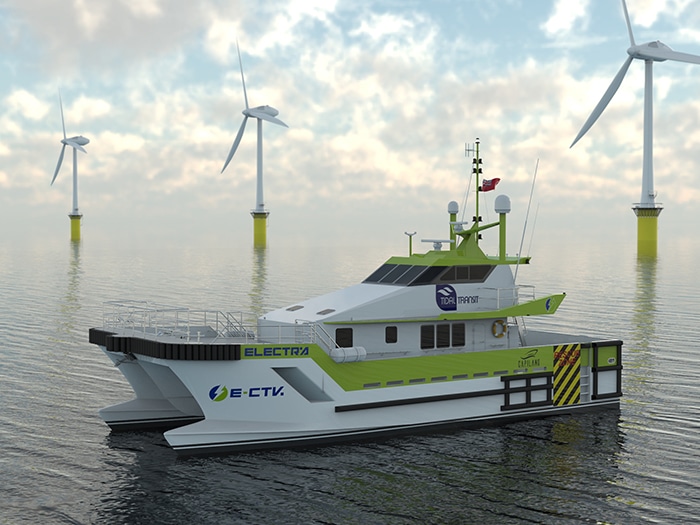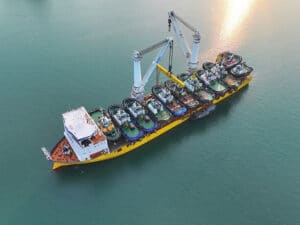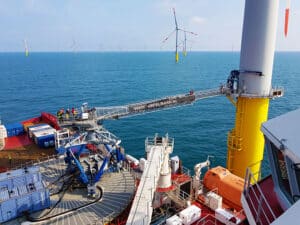
Tidal Transit project will create the world’s first retrofit eCTV
Written by Nick Blenkey
eCTV e-Ginny will featurei first-ever Volvo Penta IPS powered 100% by batteries. [Image: Volvo-Penta]
U.K. based crew transfer vessel operator Tidal Transit has begun the design and engineering phase of a project that will deliver the world’s first retrofit electric crew transfer vessel (eCTV). Like the Bibby Marine eCSOV that we reported on earlier this week, the project is supported by the U.K.’s ZEVI program, receiving GBP 6.3 million (about $7.9 million) in funding.
Over the next 15 months, Tidal Transit will retrofit the diesel-powered Mercurio 20 meter vessel, Ginny Louise, with over two megawatt-hours (MWh) of battery capacity, electric motors and propulsion pods. After being reincarnated as the e-Ginny, the CTV will not only be 100% zero emissions in operation, but will have increased maneuverability and be near silent.
As existing shoreside charging capabilities are limited, the project will include installing both an onshore charging station from Artemis Technologies, and an offshore wind turbine based-charger from MJR Power & Automation to allow for direct eCTV charging on location, greatly increasing the time and range that electric vessels can stay in operation without returning to port.
The e-Ginny project is being undertaken in partnership with boatbuilder Goodchild Marine Services. Key equipment suppliers also include Volvo Penta, Danfoss and battery system supplier Corvus Energy. On completion, the eCTV will be begin service on a U.K. windfarm for a period of three years.
Leo Hambro, commercial director at Tidal Transit, commented: “This project is a significant step forward in propelling the offshore transport industry into a new zero-carbon era. As a Norfolk-based company, we’re delighted to be working locally with our project partner Goodchild Marine and, alongside our other incredible design and engineering partners operating nationwide, continuing to lead the way in sustainable and decarbonized offshore transport.”
VOLVO PENTA IPS
The old propulsion system will be replaced with a quad Volvo Penta IPS 30 installation paired with fully electric motors and over 2 MW of on-board battery capacity.
“We are delighted to be involved with such a landmark project, which will feature our first ever Volvo Penta IPS powered 100% by batteries and with no on-board diesel generators,” said Mehmet Belibagli, sales manager, marine commercial at Volvo Penta UK. “It’s an ultra-efficient set-up that will deliver longer-range and emissions-free transfers. There’s also closer control and maneuverability so journeys are safer, faster and more reliable.”
Ad well as being emissions, free the e-Ginny will also benefit from all the other benefits that IPS delivers. These include seamless movement and control, courtesy of the forward-facing, individually-steerable drives with twin counter-rotating propellers.
For the captain and vessel operators there will be changes to the helm station with the switch to Volvo Penta IPS. These will include Volvo Penta’s joystick control, for fingertip movements, assisted docking, for stress-free positioning, and the Glass Cockpit System for a smoother driving experience. It’s part of a helm-to-prop retrofit solution that delivers improved performance and driving experience.
“Our vision is to become world leaders in sustainable power solutions and being selected for this ground-breaking project shows the important steps we are making towards our goal,” said Jan-Willem Vissers, director, marine commercial at Volvo Penta. “We believe there are many paths to net-zero, and it’s important we support our customers along whichever route they choose. It’s also important to remember the importance of remanufacturing and circularity in achieving our targets. It’s part of our business where we are putting greater emphasis and projects such as e-Ginny are a great example of how it can be done.”




